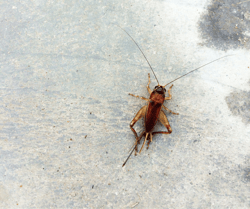Dealing with a cricket infestation in your garage can be both frustrating and disruptive. The incessant chirping, potential damage to stored items, and the challenge of locating and eliminating these elusive insects can quickly become a homeowner's nightmare. Not to mention that their constant chirping can be a big nuisance, and they can scare the wits out of you by jumping when you unsuspectingly approach them. Luckily, in this article, we'll delve into effective strategies and practical tips to help you reclaim your garage space and bid farewell to those pesky crickets once and for all. From understanding their behavior to implementing preventive measures and employing targeted removal techniques, you'll soon be equipped with the knowledge you need to restore order to your garage environment.
Cricket Biology, Behavior, and Other Facts
Crickets, members of the Gryllidae family, are small to medium-sized insects that belong to the Orthoptera order. These creatures are renowned for their distinctive chirping sound, which is produced by the males rubbing their wings together in a process called stridulation. Their distinct calls are often used to attract females and establish territories, making the nighttime chorus of crickets a familiar sound in many regions.
Crickets possess a well-defined body structure characterized by three main body parts: the head, thorax, and abdomen. They have six legs, with the hind legs adapted for jumping. Crickets are known for their strong mandibles, which they use for feeding on a variety of plant matter, fungi, and even other insects. Their compound eyes provide them with a wide field of vision, aiding them in detecting predators and locating potential mates.
The life cycle of a cricket typically involves three stages: egg, nymph, and adult. Female crickets lay their eggs in soil or other suitable environments, and these eggs hatch into nymphs, which resemble miniature versions of adult crickets but lack fully developed wings. As nymphs grow, they molt several times, shedding their exoskeletons to accommodate their increasing size. After their final molt, adult crickets emerge with fully functional wings and reproductive capabilities.
Chirping is a primary method of communication among crickets, with males producing distinct songs to attract females and establish dominance. The frequency and pattern of chirping vary among different species and can even change in response to factors like temperature. Remarkably, crickets have specialized structures called "stridulatory organs" on their wings that create the unique sounds they produce. In addition to auditory communication, crickets also use pheromones to convey information about their status, mating readiness, and territory.
Crickets play essential roles in ecosystems as both consumers and prey. They feed on decaying plant material, fungi, and smaller insects, aiding in the decomposition process and nutrient cycling. At the same time, they serve as a valuable food source for various predators, including birds, spiders, and other insects. In some cultures, crickets are considered symbols of luck or even kept as pets due to their intriguing behaviors and sounds. While their chirping may be a nuisance indoors, it's important to recognize their vital role in maintaining the delicate balance of nature.
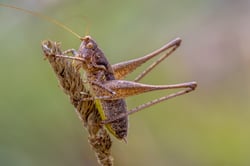 After their final molt, adult crickets emerge with fully functional wings and reproductive capabilities.
After their final molt, adult crickets emerge with fully functional wings and reproductive capabilities.
Why do crickets come indoors?
Crickets may come indoors for several reasons, often seeking shelter, food, or suitable breeding conditions. Here are some common factors that can lead crickets to venture inside homes:
- Shelter and Protection: Crickets are sensitive to environmental changes, including temperature fluctuations. As the weather turns colder or during periods of extreme heat, crickets might seek refuge indoors to escape these harsh conditions. The walls, basements, garages, and crevices of a house provide shelter from the elements and potential predators. If your garage door is open for an extended period of time, they may walk on in!
- Attracted to Light: Crickets are naturally nocturnal creatures, and they are drawn to sources of light during the night. If your indoor spaces are well-lit, especially during the evening, crickets might be lured in by the lights and inadvertently find their way indoors.
- Food Sources: Crickets are omnivores and will feed on a variety of materials, including plants, fungi, and other insects. If food sources are available inside your home, such as crumbs, food debris, or even other insects, crickets might be enticed by the prospect of a meal.
- Moisture and Humidity: Crickets require moisture to survive, and certain indoor environments might provide them with the necessary humidity. Basements, garages, crawl spaces, and bathrooms are often damp areas that can attract crickets seeking a humid habitat.
- Breeding Opportunities: If the conditions indoors are favorable for breeding, crickets might be more likely to establish themselves in your home. The availability of suitable hiding spots, along with sufficient food and water sources, can create an attractive environment for crickets to lay eggs and reproduce.
- Accidental Entry: Sometimes, crickets enter homes inadvertently through open doors, windows, or cracks in the walls. As they search for food or shelter outside, they might end up inside without a deliberate intent.
- Structural Openings: Small cracks, gaps, and openings in the walls, doors, and windows can serve as entry points for crickets. These insects are incredibly skilled at squeezing through tight spaces, allowing them to infiltrate indoor spaces.
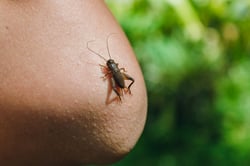 If there are food sources available inside your home, crickets might be enticed by the prospect of a meal.
If there are food sources available inside your home, crickets might be enticed by the prospect of a meal.
Can crickets damage my home or belongings?
While crickets are generally not known for causing extensive damage to homes or belongings, there are a few situations in which they might inadvertently cause some problems:
- Fabric and Paper Damage: Crickets have strong mandibles that they use for feeding. In some cases, they might chew on fabrics, paper materials, or even cardboard if they find them in their environment. However, this type of damage is usually minimal and occurs more commonly in outdoor settings where crickets have access to a wide range of materials.
- Plant Damage: If crickets find their way indoors, they might feed on houseplants or other indoor plants. While this might not result in significant harm, it can still be frustrating.
- Contamination and Droppings: Crickets, like any insects, can leave behind droppings and debris. While this might not directly damage your home or belongings, it can lead to cleanliness issues and create an unpleasant living environment.
- Noise Disturbance: Male crickets produce their characteristic chirping sounds, which can be disruptive, especially if there's a significant cricket population indoors. The noise can be bothersome, particularly during the night when it might interfere with sleep.
- Food Contamination: Crickets are opportunistic feeders and might be attracted to food crumbs or spills in your home. While they don't pose a significant health risk, their presence near food can lead to contamination and the need for extra cleaning precautions.
It's worth noting that the extent of damage caused by crickets is generally much less significant than that caused by some other pests like termites or rodents. Most cricket-related issues are more of a nuisance than a serious threat to your home or belongings. However, if you notice a large infestation of crickets or experience other pest-related problems, it's advisable to address the issue promptly to prevent any potential complications. Regular maintenance and preventive measures can help keep cricket populations under control and minimize any minor issues they might cause. The best way to achieve this is through the help of a trusted pest professional.
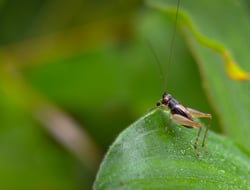 Most cricket-related issues are more of a nuisance than a serious threat to your home or belongings.
Most cricket-related issues are more of a nuisance than a serious threat to your home or belongings.
Can I prevent crickets from getting into my home and garage?
Absolutely! In fact, there are several preventive measures you can take to minimize the chances of crickets getting into your home. Here are some effective strategies:
- Seal Entry Points: Inspect your home for any gaps, cracks, or openings that crickets could use as entry points. Seal these areas using caulk, weatherstripping, or other suitable materials to prevent crickets from sneaking in. Keep the garage door closed whenever possible and install garage door sweeps so crickets don't enter from gaps under the garage doors.
- Install Screens: Use fine mesh screens on doors and windows to create a barrier that keeps crickets and other insects from entering while allowing ventilation. Make sure screens are in good condition and free from tears or gaps.
- Maintain Landscaping: Trim vegetation and shrubs near your home's foundation, as overgrown plants can provide hiding spots and easy access for crickets. Keeping the area around your house clean and well-maintained can discourage crickets from approaching.
- Reduce Outdoor Lighting: Bright lights at night can attract crickets. Consider using yellow or sodium vapor lights, which are less attractive to insects, and position them away from doors and windows to minimize the chances of crickets gathering near entry points.
- Remove Attractants: Keep your home clean and free of food debris, as crumbs and spills can attract crickets and other pests. Store food in airtight containers and promptly clean up any spills.
- Fix Moisture Issues: Address any leaks or moisture problems in and around your home. Crickets are drawn to humid environments, so reducing excess moisture can make your home less appealing to them. Also, crickets may be drawn to your garage for a water source, such as a leaky pipe, moisture under a storage refrigerator in the garage, or a pet food bowl.
- Humidity Control: Consider adding a dehumidifier to the garage and other damp areas of the home. While this may reduce the humidity in your garage to minimize crickets, your electric bill may also increase.
- Declutter: Declutter your indoor and outdoor spaces to eliminate potential hiding spots for crickets. Regularly clean and organize storage areas like basements, garages, and crawl spaces.
- Secure Trash and Compost: Ensure that trash cans are tightly sealed and that compost piles are well-contained. These sources of organic material can attract crickets and other pests.
- Professional Pest Control: If you're dealing with a persistent cricket problem, consider contacting a professional pest control service like EcoShield Pest Solutions. We can assess the situation and provide targeted treatments to eliminate crickets and implement long-term prevention strategies.
By combining these preventive measures, you can significantly reduce the likelihood of crickets entering your home and enjoy a pest-free living environment.
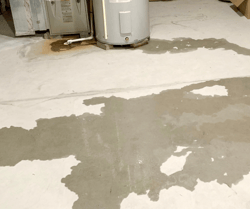 Crickets are drawn to humid environments, so reducing excess moisture can make your home less appealing to them.
Crickets are drawn to humid environments, so reducing excess moisture can make your home less appealing to them.
Can EcoShield help prevent crickets in my home?
Yes! At EcoShield, we believe prevention is the single best first-line of defense against cricket infestations. That’s why four-season protection is included in our Home Shield Protection Plan, providing a year-round defense against crickets and other pests. Have a current infestation? Not to worry! EcoShield can help remove crickets from your living spaces and curate a specialized prevention plan specifically for you. If you want to prevent or remove crickets from your home, give EcoShield a call or fill out the form on this page today to get started.
